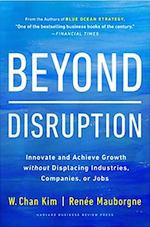C-level executives who are thinking about pushing for growth and innovation, practitioners who are asked to bring that intent to life, and entrepreneurs who are considering launching new businesses need to understand the practical steps and tools to turn aspiration into reality.
To meet this challenge, we studied whether a pattern exists in the creation process and if so, what it looks like so that we could decipher the process of “how.” How can organizations identify a nondisruptive opportunity that exists outside industry boundaries?
What Is a Nondisruptive Opportunity?
A nondisruptive opportunity is an opportunity for growth or innovation that aims to solve either an existing but unexplored issue or to address a newly emerging issue. Unlike disruption, nondisruptive opportunities involve creating a new market rather than changing an existing one.
To begin, be clear that your objective is not to disrupt or compete but to solve a brand-new problem or create and seize a brand-new opportunity. A clear intention will keep your mind focused on nondisruptive creation so that you don’t unconsciously defer to the familiar concepts of “compete” and “disrupt” in your market-creating efforts.
You want to think about pressing but overlooked issues in the world, in your industry, in your vocation, or in our lives that you are passionate about and that people or organizations are struggling with — or about burning but unseized opportunities that could, if created, make a real difference in the lives of people and communities.
As people, we naturally crave problems to solve and yearn to make a positive difference to others. We also derive immense intrinsic gratification from creating meaningful opportunities for others. These internal motivations will inspire you and your team on your journey.
Two Avenues to Nondisruptive Creation
We found that companies and individuals can take two primary avenues to create a nondisruptive market. One is to address an existing but unexplored issue or problem, and the other is to address a newly emerging issue or problem outside the boundaries of existing industries. Whether you represent a big organization or a small one, and whether your intent is to create a large nondisruptive market or a modest one, the same two avenues apply.
Address an existing but unexplored issue or problem
A brand-new problem or opportunity doesn’t necessarily mean that it suddenly popped up and never existed before. Counterintuitively, a brand-new problem or opportunity may be one that has long existed but—importantly—has remained unexplored because it hasn’t been seen as a problem to solve or an opportunity to create through a market.
An existing problem or opportunity may be taken for granted and accepted because people have patched together some form of non market solution to address the issue. For example, Kickstarter’s founders realized that most creative projects remained inside people’s heads, unrealized, for a lack of funding. Kickstarter set out to address this long-standing, ruefully accepted issue with a market solution that would open a brand-new funding opportunity for the artistic community to flourish.
Or take Mick Ebeling and Not Impossible Labs. The fact that profoundly deaf people can’t experience music didn’t just pop up. It had always existed. But they saw this not as the unfortunate fate and inevitable destiny of the deaf but as a brand-new opportunity to create. So Ebeling, Daniel Belquer, and the rest of the team at Not Impossible Labs set out to change that and offer a market solution to this unaddressed issue with Music: Not Impossible.
Address a newly emerging issue or problem
Addressing an emerging need or issue beyond existing industry boundaries is perhaps the more intuitively evident avenue to nondisruptive creation. Socioeconomic, environmental, demographic or technological changes that have an impact on society or people’s lives give rise to new problems, opportunities and issues. Offering an effective market solution to an emerging need or issue opens the door to a nondisruptive new market.
Likewise, the nondisruptive industry of cybersecurity, now valued at more than $160 billion, was created as a direct response to the burgeoning threat of cyberattacks on organizations, triggered by the rapidly emerging confluence of widespread internet access, smartphones, cloud computing and the internet of things.
E-sports, smartphone accessories, men’s cosmeceuticals and pet Halloween costumes are just a handful of the vast array of multimillion- and multi-billion-dollar nondisruptive new markets created by addressing newly emerging needs and issues that have an impact on people’s lives.
Three Ways of Identifying a Nondisruptive Opportunity
The two avenues can help you understand what problems or opportunities will generate a nondisruptive market and can lead your search efforts in the right direction. Without them, you run a risk of focusing on disruptive problems that won’t generate a nondisruptive new market even when they’re addressed.
Although knowing what is a critical first step, you also need to know how to spot these opportunities and bring them into sharp focus, whether they are existing but unexplored or newly emerging. Our research reveals three ways that companies and individuals can follow to identify a nondisruptive opportunity:
- Directly experiencing.
- Empathetically observing.
- Actively scouting.
Directly experiencing
Remember the taken-for-granted problem that Jack Dorsey and Jim McKelvey set out to solve with the Square Reader? Individuals and microbusinesses were losing sales because they couldn’t accept credit card payments. It was McKelvey’s direct loss of a sale for his glassblowing business that raised the existing but unexplored problem to his and Dorsey’s consciousness and made them passionate about solving it as they appreciated how many could benefit from this new market.
What existing but taken-for-granted problems do you or your company directly experience that no industry exists to solve? What newly emerging issues are you or your organization encountering that could create a real opportunity for you or your business, but no industry exists to address them?
Empathetically observing
A second way to identify a nondisruptive opportunity is to pay acute attention to an existing problem that is unexplored or newly emerging and that leaders indirectly experience by empathetically observing.
When Lloyd Morrisett, a cofounder of the Children’s Television Workshop, woke up one morning to find his preschool daughter watching test patterns on the television, something clicked in his mind. He started to investigate whether TV could open a brand new opportunity to educate preschool children across America.

As he shared his observation and thoughts with Joan Ganz Cooney, a PBS programmer at the time, she started to closely observe how young children interacted with TV. She saw that they not only were mesmerized by it, but effortlessly memorized and recited back all the commercial jingles popular on TV in those days. That’s when Morrisett and Cooney, the eventual cocreators of Sesame Street, saw the potential nondisruptive opportunity of using television as a medium for preschool children across America.
What existing or newly emerging issues do you or your company observe that could create a real threat or opportunity for you, your business, or people, but that no industry exists to address?
Actively scouting
A third way to identify a nondisruptive opportunity is to purposefully look for one.
Ebeling, the founder of Not Impossible Labs, and his team actively scout out problems or opportunities that are seen as impossible to solve and are in line with the labs’ core value of “technology for the sake of humanity.” They tap into all their direct and indirect contacts, networks, and communications and also visit action sites for exploration as needed.
Not Impossible Labs also assiduously scouts brand-new problems or opportunities, especially medically related ones, by inviting people to submit them. If a submission resonates with the Not Impossible Labs team and aligns with their core value, and they believe that a solution could make a real difference, the team sets out to create a market solution.
Are you actively scouting brand-new problems to solve and brand new opportunities to create that no industry exists to address? Do you have a mechanism or a process for achieving this effectively?
Assessing and Framing the Opportunity for the Next Step
Once you identify the opportunity, you should take two actions. The first is to ask, Who other than you cares about this problem or opportunity? What are the market potential and the impact potential of the nondisruptive opportunity you have identified? Market and impact potentials need to be assessed in terms of both economic gain and wider benefits for society.
This assessment will help you see whether the opportunity you’ve identified is a likely candidate to meet your objective or purpose.
Like the founders of the nondisruptive markets we’ve detailed, you want to be sure that the opportunity you have identified is not just a burning issue for you. It should be an issue that has real relevance to others and thus has true market and impact potential. In other words, you want to be clear on who truly cares other than you. You should assess the size of its potential market up front, before you pour in your time and resources.
It needn’t promise to touch and be relevant to as many people as those that led to the Square Reader, Grameen Bank or Sesame Street. What matters is your organization’s size and ambitions and what you are passionate about.
If your ambition is big, you need to check that the number of those struggling from it or who could benefit by it in a meaningful way is large. And if your ambition is smaller, you need to check that the problem or opportunity you aim to address will deliver compelling value for the select population you imagine it for.
It’s crucial not only to assess the size of the market potential, but also to atomize the challenge for you and your team so that you are not overwhelmed and ultimately demotivated by the breadth of the problem or opportunity.
Essentially, atomizing your nondisruptive opportunity makes it much more mentally attainable. It frames the challenge on a more human scale that effectively relaxes us so that our minds can go to work and not be frozen like a deer in headlights by the scope of what we set out to create.
***
Reprinted by permission of Harvard Business Review Press. Adapted from Beyond Disruption: Innovate and Achieve Growth Without Displacing Industries, Companies, or Jobs, by W. Chan Kim and Renée Mauborgne. Copyright © 2023 by Harvard Business School Publishing Corporation. All rights reserved.





